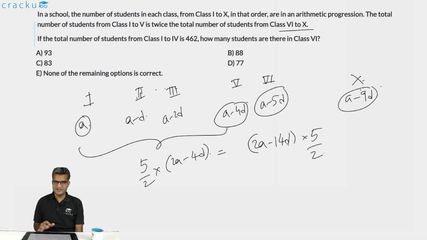In a school, the number of students in each class, from Class I to X, in that order, are in an arithmetic progression. The total number of students from Class I to V is twice the total number of students from Class VI to X.
If the total number of students from Class I to IV is 462, how many students are there in Class VI?
The number of students from 1 to 10 is in AP. Let's assume the series as follows:
a, a+d, a+2d, a+3d, a+4d, a+5d, a+6d, a+7d, a+8d, a+9d.
Given that the sum of the number of students in the first four classes is 462.
So, a +a+d+ a+2d+ a+3d=4a+6d=462 => 2a +3d=231--->1
It is also given that the total number of students from Class I to V is twice the total number of students from Class VI to X.
So, 5a+10d = 2*(5a+35d).
5a+10d=10a+70d
5a+60d=0 --> 2
Solving equations 1 and 2.
Multiply equation 1 with 20.
We get 40a+60d=4620--->3. Subtract equation 2 from equation 3.
We get 35a=4620
=> a=132.
Substitute a value in equation 2. We get 60d=-660=>d=-11.
Now, we have to calculate the number of students in class VI.
That is a+5d=132-5*11=77.
Video Solution

Create a FREE account and get:
- All Quant Formulas and shortcuts PDF
- 15 XAT previous papers with solutions PDF
- XAT Trial Classes for FREE




